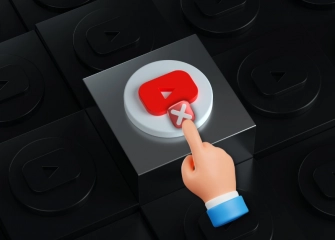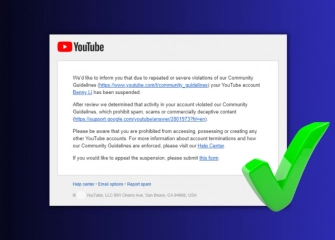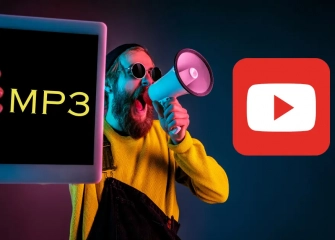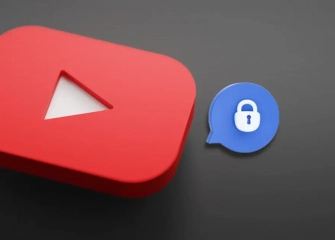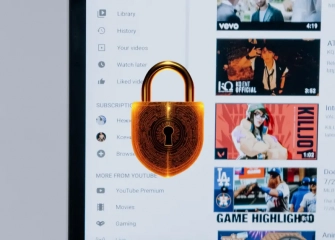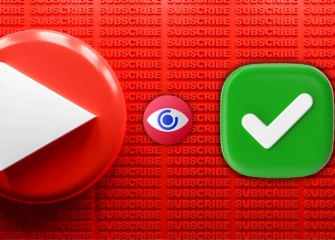What is YouTube SEO? - How to Do It?
With YouTube SEO, you can make your videos more visible on the platform and get more views and subscribers. YouTube SEO includes optimization efforts that help your videos rank higher in search results.

Factors like title, description, tags, thumbnail, and watch time affect how the YouTube algorithm evaluates your video. When applied with the right strategies, your content can reach more people organically and help your channel grow faster. So, how do you do YouTube SEO?
To increase your subscriber count on YouTube, check out our buy Youtube subscribers page!
What is YouTube SEO?

YouTube SEO is the process of optimizing your videos so they appear higher in YouTube search results and in suggested videos. The main goal is to increase your videos’ visibility, help viewers find your content more easily, and boost engagement.
Since YouTube uses an algorithm that prioritizes user experience, SEO strategies focus not only on keywords but also on viewer behavior. Key elements of YouTube SEO include titles, descriptions, tags, thumbnails, captions and transcripts, watch time, engagement data, and channel optimization.
The title should clearly summarize the video’s topic and naturally include your target keywords. It should also grab attention and encourage viewers to click. The description provides a detailed explanation of the video. Keywords should be used naturally, and the description should clearly explain the topic, what information the video offers, and how it benefits viewers.
Descriptions can also include relevant links and calls-to-action to guide viewers to interact. Tags help YouTube understand the topic and scope of your video. Using accurate and relevant tags helps your video reach the right audience.
Viewers often base their decision to watch your video on the appeal of its thumbnail. An attractive, clear, and high-quality thumbnail increases click-through rates. Captions and transcripts make your video easier to understand and more accessible, especially for viewers who speak different languages or for those with hearing impairments.
Engagement metrics like watch time, likes, comments, and shares directly affect how YouTube evaluates your video’s value. Higher engagement makes the algorithm more likely to recommend your video to more people.
Channel optimization is also an important part of YouTube SEO. A strong channel description, playlists, profile photo, banner, and consistent content uploads boost your channel’s authority and reliability, supporting your videos’ SEO performance. Playlists that group similar content together also increase watch time, which positively impacts SEO.
How to Do YouTube SEO?

YouTube SEO refers to the process of optimizing your videos so they appear higher in YouTube search results and in the recommended videos list. When done right, your videos reach more viewers, your channel becomes more visible, and your target audience can find your content more easily.
The main elements of YouTube SEO include choosing the right title, writing the description, using tags, creating an eye-catching thumbnail, adding subtitles, and increasing watch time. Using these elements effectively helps your videos stand out in both searches and recommendations. Here are some YouTube SEO techniques:
Find the Right and Relevant Keywords
Keywords are the terms or expressions users enter into search engines to locate the information, products, content, or websites they are looking for. Since these keywords directly reflect users’ needs and search intent, they are very important for digital marketing and content creation.
Algorithms on search engines and platforms like YouTube scan the keywords in your content to determine which content best matches users’ searches. In other words, the words users type affect how visible your content will be.
By incorporating the terms your audience searches for most often into your content, you can greatly boost your likelihood of appearing higher in search engine results. YouTube also acts as a search engine in its own right.
That’s why using the right keywords in your video titles, descriptions, and tags helps your videos reach a wider audience. Choosing the right keywords not only increases your video’s views but also improves the chance of appearing in recommended videos.
Discovering the right keywords is essential for YouTube SEO and greatly influences how content is developed. It shows which keywords are searched more often, which terms people use to find videos, and how competitive they are. This way, you can plan your content strategy to be user-focused and search engine-friendly, maximizing your chances of reaching your audience.
Give Importance to Your Video Title
When sharing content on YouTube or other video platforms, the title is one of the most important things that grabs viewers’ attention. A good title makes your video noticeable, increases click rates, and helps you reach the right audience.
A title doesn’t just summarize your video’s topic; it should also spark curiosity, be clear, and include keywords that match search engines. This way, you can attract viewers and make it easier for the platform’s algorithms to recommend your video.
The right title strategy can boost your video’s visibility, directly increasing views and helping your channel grow. Make sure your primary keyword appears in your headline. If there’s space and it fits naturally, you can also add a long-tail keyword to your full title to rank higher in search results. But make sure adding keywords doesn’t make your title less clear or interesting.
A title that encourages clicks should also reflect the content of the video accurately. This improves viewer satisfaction and watch time, which helps algorithms recommend your video more often.
Also, try to keep your title as short as possible. Around 47–48 characters usually works best, making it look good on mobile devices and quickly grabbing attention. Short and concise titles are especially effective for viewers who consume content quickly.
Don’t Forget to Use Tags
Don’t forget to include appropriate tags for your YouTube videos! Tags, just like hashtags on Instagram, play an important role in helping YouTube’s algorithm understand what your video is about. Using the right tags also helps determine which viewers will see your video and which other videos it will be suggested alongside.
Using tags that directly relate to your video helps the algorithm categorize it correctly. Choosing tags that relate to each other and align with your content helps YouTube understand your video and deliver it to the right viewers.
YouTube allows a maximum of 120 characters for all tags combined. So instead of adding a lot of random tags, focus on 3–5 tags that are most relevant to your video. This way, your video is easier for the algorithm to understand and has a higher chance of showing up in the suggested videos list.
Studying your competitors’ videos to see which tags they use can also give you a big advantage. You can learn from their strategies and optimize your own tags to increase your chances of getting more views than your competitors.
Using popular and relevant tags in the right combinations helps your video get more organic views and reach the right audience. Tags don’t just signal the algorithm—they also help your video appear in YouTube’s recommended videos system. That’s why choosing your tags carefully is a key part of YouTube SEO.
Optimize Your Descriptions
The description section on YouTube gives you a large space to write—up to 5,000 characters. This makes it a key part of your video’s YouTube SEO. YouTube scans the text in your description to understand what your content is about. Other search engines like Google and Bing also analyze this text to show your videos in relevant searches.
While not as important as your video title, the description is one of the main elements that helps search engines categorize your video correctly. The words and sentences you use clearly tell both YouTube and other search engines what your video covers.
Since you have up to 5,000 characters, you can explain your content in detail, provide extra information for viewers, and share links or resources related to your video. Using this space well directly helps your video rank higher in search results. For example, you can naturally include keywords in your description to highlight the topics your video covers.
You can also add links to your social media, website, or other content to guide viewers, which improves user experience and brings extra traffic to your channel. Another important point is that the description isn’t just for text.
You can use hashtags (#) to connect your video to certain categories and add timestamps to help viewers jump to the parts they want. This improves both user experience and YouTube’s understanding of your video. The YouTube description is not only for summarizing your video but also a valuable tool for boosting SEO and viewer engagement.
Using it effectively increases your video’s chances of being discovered and improves your channel’s overall visibility. When filling out your description, including keywords, relevant links, helpful information, and calls to action is one of the most effective ways to strengthen your YouTube SEO.
Change Your File Name When Uploading Videos
Your video’s file name holds as much significance as its title, description, and tags. Search engines look at it when crawling your content. A clear and descriptive file name that directly reflects your video’s topic helps YouTube and Google quickly understand what your video is about.
Giving your file an SEO-friendly name before uploading can make a big difference. Especially if the file name summarizes your video’s topic or includes your target keyword, it can boost your visibility in search results and increase the chances of reaching the right audience.
The key is to keep your file name short, clear, and descriptive. Instead of using complex or meaningless names, use phrases from your video title or long-tail keywords. This is much more effective for SEO.
For example, a file name like “best-coffee-recipes-2025.mp4” makes it easy for both users and algorithms to understand your video’s content. Your video’s file name is a crucial part of content optimization and supports the overall SEO strategy.
Add Subtitles to Your Videos
Just like your video description, subtitles are another key area that YouTube scans and analyzes. Subtitles turn the speech in your video into text, helping YouTube’s algorithm understand your video’s topic, scope, and value for viewers.
You don’t need to make it complicated. Just include subtitles in the same language, keeping them as accurate and true to the spoken words as you can. This ensures your subtitles match the content perfectly, allowing YouTube to classify your video correctly.
Another big benefit of subtitles is accessibility. Hearing-impaired viewers can follow your videos easily and enjoy the content just like anyone else. This allows you to connect with more people and boost your views.
Plus, if you add subtitles in different languages, you can attract international viewers and make your video more visible worldwide. Subtitles aren’t just for algorithms—they also improve the viewer experience, make your videos look more professional, and make your content easier for everyone to access.
Add Your Related Videos to a Playlist
By adding your related videos to the right playlists, you can keep viewers on your channel longer and guide them to the content they’ll enjoy. This way, users can easily find what interests them, and the time they spend on your channel increases.
Playlists let viewers explore a series of connected videos instead of just watching one. As your videos get more views, your channel also becomes more visible in YouTube’s algorithm. This improves the user experience and gives viewers more complete information, increasing your chances of ranking higher on YouTube. Playlists show that your channel is organized and professional, while also encouraging viewers to come back again.
What Are the Advantages of Doing YouTube SEO?

YouTube is now the world’s second-largest search engine. At first, it was just a platform for uploading and sharing videos, but over time it has become a full-fledged search engine and marketing tool.
Today, it’s not just about sharing content—it’s a powerful platform that helps brands and creators reach their target audience. To better understand YouTube’s importance, let’s look at some stats:
- Over 3 billion searches are done on YouTube every month. This shows that the platform is much more than a video-sharing site—it’s a huge hub for finding information and content.
- YouTube has a larger volume than all the other big search engines combined, like Bing, Yahoo, Ask, and AOL. This highlights how crucial it is for content discovery and visibility.
- Every minute, roughly 100 hours of fresh video content is added. This means creators are competing to stand out among millions of videos, making smart SEO strategies essential.
Grasping YouTube’s mechanics is essential for building an effective content plan. Similar to Google, YouTube relies on a sophisticated algorithm that ranks videos according to user searches and viewing habits. So, to make sure your content reaches the right audience, you need to follow YouTube SEO best practices.
YouTube SEO involves using methods and tactics to help your videos get discovered, connect with the right audience, and boost their visibility on the platform. Many factors—like titles, descriptions, tags, thumbnails, captions, and user engagement—affect how your video is recommended by the algorithm and how high it ranks.
Benefits of YouTube SEO

Optimizing for YouTube SEO can significantly boost the visibility of your content. It helps you reach new and relevant viewers who haven’t met your brand yet, not just your current subscribers. As a result, your videos reach a larger audience, your website sees higher traffic, and you draw in users with a greater chance of making a purchase.
In other words, YouTube SEO doesn’t just improve view counts—it becomes a long-term strategic tool to grow your business and boost brand awareness. Nowadays, natural growth is playing an increasingly crucial role in digital marketing.
YouTube SEO offers a highly efficient and sustainable method to boost this growth without excessive costs. Paid ads can give temporary visibility, but content optimized for YouTube SEO can be discovered organically for a long time.
This helps your channel and brand build a lasting digital presence, going beyond quick returns on investment. Often, the results from YouTube SEO can be more efficient than paid campaigns. Ads only work while you pay for them—once the budget stops, traffic drops and views decrease.
But properly optimized videos, with strategic keywords, eye-catching and clear titles, detailed descriptions, and relevant tags, are supported by YouTube’s algorithm over time. This leads to steadily increasing views, new subscribers, and organic traffic to your website.
However, to get these benefits, videos must follow SEO best practices. Every element—from titles and descriptions to tags and transcripts—directly affects how YouTube evaluates your content and which viewers it recommends it to.
These technical details, along with content quality, play a key role in your channel’s growth. Additionally, metrics like average watch time, likes, comments, shares, and user engagement rates are among the most important factors for ranking.
Therefore, succeeding with YouTube SEO demands both persistence and regular effort. Instead of expecting big results quickly, it’s important to take a regular, strategic approach. Ranking well in search results requires producing unique and captivating videos, applying effective SEO strategies, and fostering a meaningful relationship with your viewers.
Also, attention-grabbing thumbnails, clear subtitles, and well-organized playlists help increase your organic reach. This disciplined approach not only helps your channel grow but also strengthens your brand’s online authority, establishes trust in your industry, and becomes a cornerstone of your long-term digital marketing strategy.
What Are the Best YouTube SEO Tools?

Success on YouTube isn’t just about creating high-quality content; it’s also about making sure the right people find it. This is where YouTube SEO tools come in. By applying effective strategies, you can greatly improve your videos’ visibility.
YouTube SEO involves the techniques, approaches, and tools designed to boost your videos’ positions in search results. Using the right tools doesn’t just boost views—it also accelerates your channel’s growth, strengthens your brand awareness, and helps you engage more deeply with your target audience. These are some of the top tools to boost your YouTube SEO:
YouTube Analytics
YouTube Analytics is a powerful tool that lets you analyze your channel’s performance in detail. You can track which videos get the most views and engagement, view audience demographics, watch times, click-through rates, and subscriber growth.
This data helps improve your content strategy and shows which types of videos add the most value to your channel. You can study how viewers interact with your videos and adjust your content to match their preferences. For example, seeing where viewers drop off in a video can help you optimize its structure.
Google Trends
Google Trends is ideal for discovering current trends, seeing what people are curious about, and tracking changes in keyword popularity. It’s essential for creators who want to produce content that aligns with trending topics.
With Google Trends, you can compare two or more keywords, see which one gets more attention, and optimize your content accordingly. This helps your videos reach more users through trending searches and target topics with high view potential.
TubeBuddy
TubeBuddy is an all-in-one browser tool made for content creators. It allows you to do keyword research, optimize titles, tags, and descriptions, and perform competitor analysis. Advanced features like thumbnail testing, publishing time recommendations, and video SEO scores make channel management much easier. Using TubeBuddy can make your content SEO-strong, give you an advantage in search rankings, save you time, and help you create a data-driven content strategy.
VidIQ
VidIQ is another tool that can take your YouTube channel to the next level. It helps you optimize your content by analyzing keyword scores, competition, engagement rates, and viewer behavior. It also provides recommendations to improve your SEO performance so your content keeps getting better. The “Popular Videos” feature lets you identify high-potential titles, allowing you to strengthen your channel with trending content.
Keyword Tool (for YouTube)
Keyword Tool analyzes phrases that users frequently search for in YouTube’s search bar and gives you new keyword ideas. This helps you understand what your target audience is searching for and use those keywords strategically in your videos to boost visibility. Keyword optimization plays a critical role in reaching the right audience.
Social Blade
Social Blade is a comprehensive tool to track your channel’s overall performance and perform competitor analysis. You can access metrics like daily, weekly, and monthly subscriber growth, view counts, estimated earnings, and channel rankings. This information helps you monitor your channel’s growth and make informed strategies by comparing yourself to competitors.
How Does the YouTube Algorithm Work?

Key elements that influence YouTube rankings include the video’s title, its description, and how closely the content aligns with what viewers are searching for. This match not only increases user engagement on the platform but also ensures better success in search engine optimization (SEO).
In other words, using the right keywords and aligning them with your content directly helps your video become more visible both on YouTube and on external search engines like Google. Integrating relevant keywords into the title and description makes it easier for your target audience to find your video.
But the critical point here isn’t just adding keywords—it’s making sure the video content actually matches them. If viewers can’t find the information or entertainment they’re looking for, the video’s performance suffers. That’s why keyword-content alignment plays a vital role in user satisfaction.
YouTube’s algorithm doesn’t just look at written keywords; it also analyzes whether the video meets viewer expectations. Technical SEO elements like titles, descriptions, and tags are important, but the strongest signals come from viewer behavior. V
iewer behavior is the key factor that determines how often your video is recommended and how visible it is overall. According to YouTube, viewer engagement directly affects how often videos are recommended and their general visibility on the platform. This is measured through several criteria:
- Watch Preferences: Content suggested based on a user’s past viewing history and interests directly affects the likelihood of your video being highlighted.
- Average Watch Time: How long viewers stay on your video shows how engaging your content is. Grabbing attention early is critical.
- Click-Through Rate (CTR): If your title and thumbnail convince users to click, the algorithm recommends your video to a wider audience.
- Subscription Data: If viewers subscribe to your channel after watching, it signals that the content is valuable.
- Likes, Dislikes, and Comments: Viewer engagement shows that the video is interesting and connects with the community.
- End-of-Video Interaction: When viewers encounter other content at the end, traffic to your channel increases.
- Shares: Being shared on social media or messaging apps indicates that your content is high-quality and engaging.
- “Not Interested” Feedback: Negative feedback may reduce how often the video is recommended.
Additionally, factors like using subtitles, organizing content into playlists, live streams, and Shorts also influence the algorithm. Subtitles, in particular, help search engines understand your video more easily and improve accessibility.
Adding videos to playlists helps viewers stay on your channel for more time, boosting your average watch duration.YouTube’s main recommendation is that creators understand their audience well and produce content that grabs attention, whether emotionally or informationally.
The algorithm constantly monitors how viewers interact with videos and pushes the ones with higher engagement to reach more people. The more people watch, comment on, share your videos, and subscribe because of them, the greater your visibility becomes.
After reading this content, be sure to check out our article titled “What is YouTube Hype?”

